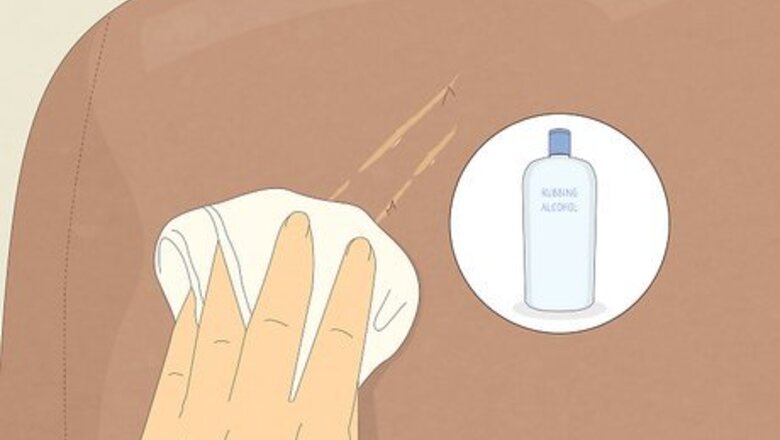
views
- To repair deeper scratches in leather, apply leather heavy filler. It has a putty-like consistency that's perfect for filling in cracks and scratches, and it dries within 30 minutes.
- For smaller scratches, you might be able to repair them just by applying an oil, like olive oil, baby oil, or lanolin oil.
- Applying shoe polish in a color that matches the leather may help disguise any scratches.
Repairing a Deeper Scratch
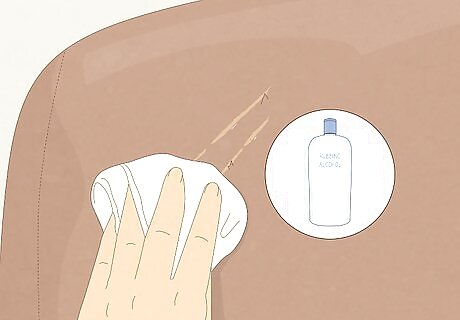
Clean the area with rubbing alcohol. Deep scratches in leather furniture may be scuffed and dirty, so before you attempt to repair the area, make sure it’s clean first. Take a clean cloth and dip it in rubbing alcohol, then lightly buff the scratched area. Rubbing alcohol dries quickly. Let the area sit for about 10 minutes, and it should be dry. This method works most effectively with finished leather. If you have a deep cut in aniline leather, it may be irreparable.
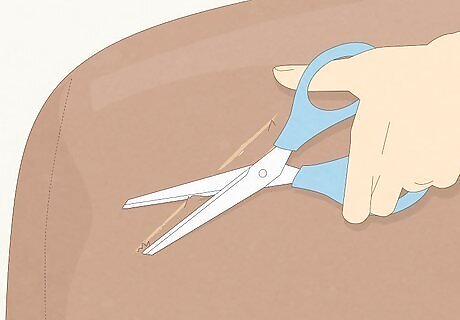
Sand or clip loose fibers around the edges of the cut. Unlike with a minor scratch, if your leather furniture is deeply scratched, the leather may be uneven, scuffed, or torn around the fringe of the scratch. Take a pair of scissors, and clip away any loose threads so that the area around the cut is smooth. Alternately, take a piece of fine-grit sandpaper (around 1200 grit) and sand the area surrounding the cut until it’s smooth.
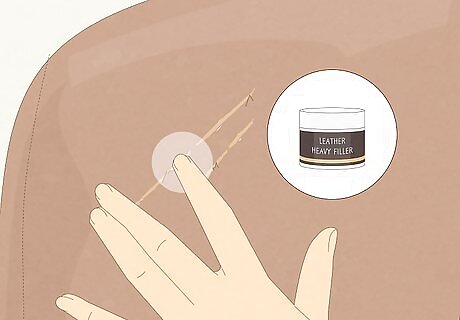
Apply leather heavy filler to the scratched area. Called “filler” for short, this material has the consistency of putty and will fill the gaps or cracks in the scratched section of your furniture. Using your finger or a small spatula, cover the scratch with heavy filler, until the scratched surface is even with the rest of the furniture’s surface. Once you have applied the heavy filler, let it dry for about 30 minutes. Once the filler has been applied, take another sheet of 1200 grit sandpaper and smooth the surface of the filler. Leather heavy filler should be available at your local hardware store, or at a leather-goods store. Additionally, the furniture manufacturer may sell bonder or filler, or even send you some for free.
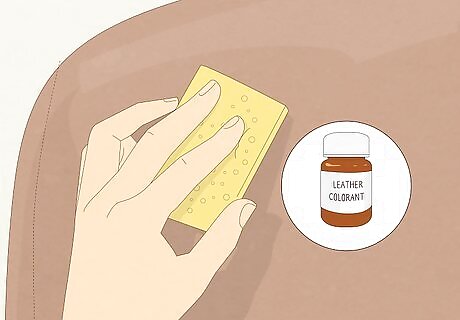
Apply the correct shade of leather colorant. Now that the scratch has been sealed and covered with heavy filler, you’ll need to color the material to match the rest of the furniture piece. Apply the colorant to a sponge, and dab it evenly across the area covered by the heavy filler. Apply as many coats as necessary to match the color of the furniture, but remember to let each coat dry before applying a new one. To purchase leather colorant, you’ll likely need to visit a leather-goods store or a furniture store that specializes in leather.

Apply a leather finish to the colored area. This will seal and protect the dyed heavy filler, and should prevent the same area from being scratched again. Pour a small amount of the finish onto a sponge or clean cloth, and then lightly rub onto the scratched area of your furniture. Apply up to 3 or 4 coats for a consistent finish. As for the leather colorant, you’ll probably need to purchase the leather finish at leather-goods store or a furniture store that specializes in leather. You may be able to purchase the heavy filler, colorant, and finish all together in a leather-repair set.
Recognizing the Type of Leather and Scratch
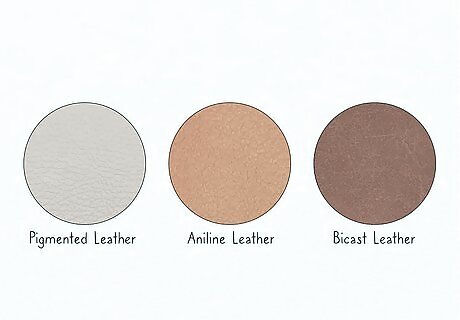
Identify the type of leather that your furniture is made from. You can do this with a close inspection of the furniture piece. Since different types of leather are repaired differently, it’s important to begin by identifying your furniture’s leather type. The three types of leather used to make furniture are: “pigmented” (or “finished”) leather, “aniline” leather, and “bicast” leather. Most leather furniture (about 85%) is made from finished leather. This leather has a durable surface that resists scratching, and does not absorb liquids. Aniline leather is made from very high-quality leather, and so aniline furniture is rare. Aniline leather does not have a surface coating, so the texture of the leather can be seen. Companies also produce semi-aniline leather, which is still made of high-quality leather, but are covered in a thin layer of coating. Bicast leather is technically a leather byproduct, although furniture made with bicast is still considered leather furniture. Bicast leather is made from inferior-quality leather, which is split into a thin layer, and then laminated to a polyurethane top layer.

Call the manufacturer of your leather furniture when you notice a scratch. Many manufacturers have specific ways they recommend to fix or repair their pieces of furniture. Sometimes they will even send you a free or discounted repair kit. If you do not have any luck with this step, proceed on to the next step. The repair procedure that the manufacturer may recommend will be directly related to the leather type.
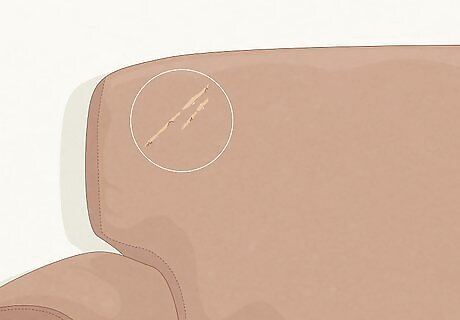
Assess the type of scratch. Leather furniture can be scratched with different levels of severity. While a minor scratch will be easy to fix, a deeper tear in the leather is more serious and will require different procedures. You can determine how seriously your furniture has been scratched with a quick visual assessment. If the scratch is minor, only the coating of the leather will have been scratched, and the underlying leather itself will be intact. Deeper scratches mean that the leather itself has been cut. You may be able to see leather fibers around the fringe of the cut. If the leather has been completely cut through, you may even be able to see the inner stuffing of the furniture. At this point, you will not be able to fully patch the scratch on your own, and you’ll need to take the furniture to a professional.
Fixing a Small Scratch
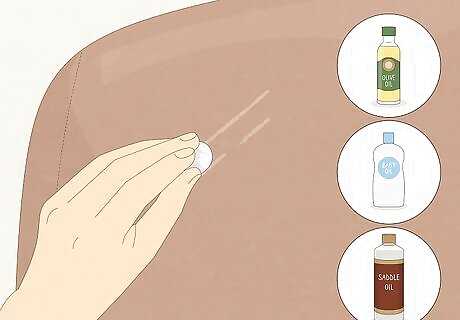
Rub olive oil, baby oil or saddle oil into the scratch. Use a cotton-swab applicator (such as a cotton ball or a Q-tip) for the procedure. After applying the oil directly to the scratch, rub it into the surrounding leather with a circular motion. Allow the oil to dry for an hour, then wipe it off with a clean cloth. If the scratch has not repaired itself after the first application of oil, try applying more oil, and let it sit for several hours. As with all steps, test this in an inconspicuous area first as oil may absorb into the leather causing it to stain/darken.
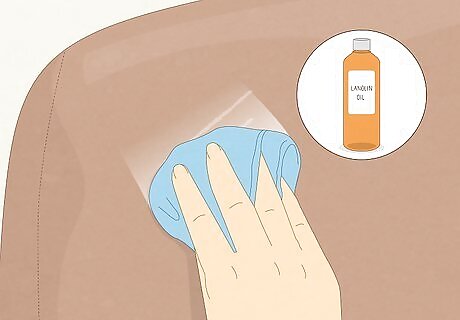
Apply lanolin oil to the scratch. Find a clean cloth, such as a cotton rag, and dip the cloth in lanolin cream. Rub the cloth over the scratched area, perpendicular to the direction of the cut. This will smooth and repair the scratch, although it may take several re-applications before the scratch becomes invisible. Test the lanolin oil on a seldom-seen section of leather, as the oil may darken the color of the material.
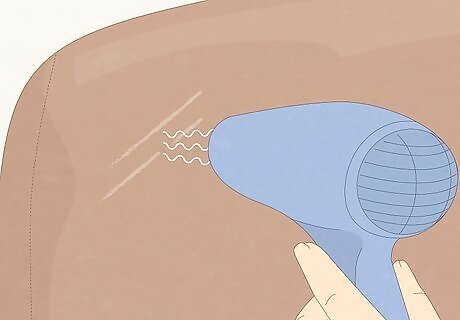
Use a heat source and a damp cloth to bring out the leather oil. Before proceeding with this step, it is critical to be aware of your leather type. This process will only work on aniline leather types, as well as on bicast leather. To heat the leather, hold a hair dryer very close to the cloth, or press a warm iron against a damp cloth laid over the scratch. If you’re applying heat from a hair dryer, use your hands to massage the leather around the scratch. The heat should bring out the natural oil and dyes in the leather. If it does, the scratch may heal itself as a result. If you’re using an iron and damp cloth, hold the iron on for 10 seconds. Remove it, and look at the scratch. If it seems to have disappeared, dry off the leather and prepare to use as normal. If the scratch is still there, repeat the step with the iron once more. Avoid burning the leather. If it is uncomfortably hot to the touch, let the leather cool off before you re-apply any heat.
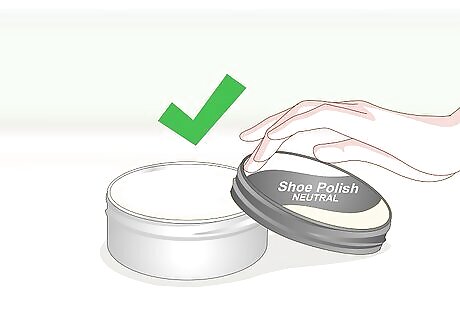
Apply shoe polish to the scratched area. Find a shade of shoe polish that matches your furniture. First, apply the shoe polish to the scratches with a clean cloth or a cotton-swab applicator. Then rub the shoe polish into the leather and, with a clean cloth, rub the scratch quickly to buff it. This process will not heal the scratches, but it may help to disguise them. If the color needs to be darker, repeat with another coat. If the color does not match your furniture once you have applied it, use a damp rag to wash it off immediately. This process will be successful with more heavily pigmented leather (and also bicast leather), since shoe polish is not generally designed for use on furniture-grade leather.



















Comments
0 comment